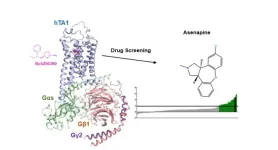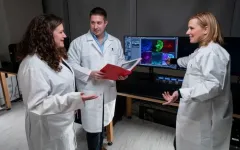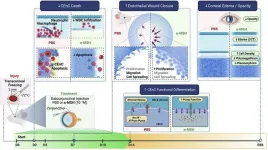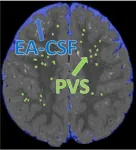(Press-News.org) In a world grappling with the complexities of mental health conditions like anxiety, depression, and PTSD, new research from Boston University neuroscientist Dr. Steve Ramirez and collaborators offers a unique perspective. The study, recently published in the Journal of Neuroscience, delves into the intricate relationship between fear memories, brain function, and behavioral responses. Dr. Ramirez, along with his co-authors Kaitlyn Dorst, Ryan Senne, Anh Diep, Antje de Boer, Rebecca Suthard, Heloise Leblanc, Evan Ruesch, Sara Skelton, Olivia McKissick, and John Bladon, explore the elusive concept of fear engrams, shedding light on the physical manifestation of memory in the brain. As Ramirez emphasizes, the initiative was led by Dorst and Senne, with the project serving as the cornerstone of Dorst’s PhD.
Beyond its implications for neuroscience, their research marks significant strides in understanding memory formation and holds promise for advancing our comprehension of various behavioral responses in different situations, with potential applications in the realm of mental health. In this Q&A, Dr. Ramirez discusses the motivations, challenges, and key findings of the study.
What motivated you and your research collaborators to study the influence of fear memories on behavior in different environments?
The first thing is that with fear memories, it’s one of the most, if not the most, most studied kind of memory in rodents. It’s something that gives us a quantitative, measurable behavioral readout. So when an animal’s in a fearful state, we can begin looking at how its behavior has changed and mark those changes in behavior as like an index of fear. Fear memories in particular are our point because they lead to some stereotyped behaviors in animals such as freezing in place, which is one of many ways that fear manifests behaviorally in rodents..
So that’s one angle. The second angle being that fear is such a core component of a variety of pathological states in the brain. So including probably especially PTSD, but also including generalized anxiety, for instance, and even certain components of depression for that matter. So there’s a very direct link between a fear memory and its capacity to evolve or devolve in a sense into a pathological state such as PTSD. It gives us a window into what’s going on in those instances as well. We studied fear because we can measure it predictably in rodents, and it has direct translational relevance in disorders involving dysregulated fear responses as well.
Can you explain what fear engrams are and how you used optogenetics to reactivate them in the hippocampus?
An engram is this elusive term that generally means the physical manifestation of memory. So, whatever memory’s physical identity is in the brain, that’s what we term an engram. The overall architecture in the brain that supports the building that is memory. I say elusive because we don’t really know what memory fully looks like in the brain. And we definitely don’t know what an engram looks like. But, we do have tips of the iceberg kind of hints that for the past decade, we’ve been able to really use a lot of cutting edge tools in neuroscience to study.
In our lab, we’ve made a lot of headway in visualizing the physical substrates of memories in the brain. For instance, we know that there’s cells throughout the brain. It’s a 3D phenomenon distributed throughout the brain but there’s cells throughout the brain that are involved in the formation of a given memory such as a fear memory and that there’s areas of the brain that are particularly active during the formation of a memory.
What were the main findings about freezing behavior in smaller versus larger environments during fear memory reactivation?
It’s thankfully straightforward and science is often anything but. First, if we reactivate this fear memory when the animals are in a small environment, then they’ll default to freezing–they stay in place. This is presumably an adaptive response so as to avoid detection by a potential threat. We think the brain has done the calculus of, can I escape this environment? Perhaps not. Let me sit in a corner and be vigilant and try to detect any potential threats. Thus, the behavior manifests as freezing.
The neat part is that in that same animal, if we reactivate the exact same cells that led to freezing in the small environment, everything is the exact same: the cells that we’re activating, the fear memory that it corresponds to, the works. But, if we do that in a large environment, then it all goes away. The animals don’t freeze anymore. If anything, a different repertoire of behaviors emerge. Basically, they start doing other things that is just not freezing, and that was the initial take home for us, was that they, when we reactivate the fear memory up, or artificially, when we do that in the small environment, they freeze, when we do that in the large environment, they don’t freeze.
What was cool for us about that finding in particular was that it means that these fear memory cells are not hardwired to produce the same exact response every single time they’re reactivated. At some point, the brain determines, “I’m recalling a fear memory and now I have to figure out what’s the most adaptive response.”
Were there any challenges or obstacles you encountered during the research process, and how did you overcome them?
There’s a couple. The first is that the behavior, ironically enough, was reasonably straightforward for us to reproduce and to do again and again and again–so that we were convinced that there was some element of truth there. In the second half of the study, and the one that probably takes up the most space in the paper, was figuring out what in the brain is mediating this difference. As we observed, the animals are freezing when we artificially activate a memory in a small environment, and they’re not freezing in the large environment. But, we’re activating the same cells. So, what is different about the animal’s brain state? What is the animal’s brain state when we’re reactivating this memory in the small environment compared to the large environment? Clearly it’s manifesting as totally opposite behaviors–freezing and lack thereof.
So, we wanted to find out what in the brain is happening in those two conditions that are different. That led us down a multi-year rabbit hole of trying to map out activity patterns in the entire brain, as a result of stimulating these memories in these different sized environments. We went through a whole mess of technologies where we looked at the brain–we can actually make the brain completely transparent–so that we can take fancy microscopes and image the brain in three dimensions. Think of it as a cellular MRI for rodents. We created these brain wide maps of what’s responsive in the brain when we stimulate a memory. Then we asked ourselves, how does that map of the brain in the small environment compare to the map of the brain when we’re activating the memory in the large environment?
In short, there’s similarities and there’s differences. That there’s certain parts of the brain that are always active when we stimulate a memory, regardless of the environments that the animals are in. But, then there’s other parts that are only active in the large environment or only active when we do the experiment in the small environment. That’s neat because that lets us know that those areas that are not in common between the two might be the ones that are actually important in mediating the brain’s decision to either freeze or to not freeze. However, this process was challenging because it required a lot of technical prowess such as making brains transparent and imaging them in three dimensions down at the cellular level.
How might the insights from this research be applied or extended in the future, particularly in the context of understanding and treating fear-related disorders?
Context clearly matters. One relatable example is that two people might be experiencing the same level of anxiety, but the underlying reason for that anxiety might be wildly different across the two people. The ways that anxiety affects the people behaviorally may also be very different. One person might be pacing up and down the room, whereas the other one is just kind of sitting and lost in their own thoughts. The same faculty of cognition can appear two very different ways, in how it’s expressed. In this case, we think it’s the same thing with fear memories — how they’re expressed will depend on what the animal is experiencing. Perhaps in people, how a given memory is expressed also is going to depend on the context, like the who’s there, the what, where, why, and so on.
So that’s one angle, but I think that the more direct relevance is that we’ve known for a decade that these cells in the hippocampus are enough to jumpstart a memory when we reactivate them. But then there’s the question of, what happens if we reactivate them, and we change up more than just the environment size? If we activate a fear memory, but while an animal is with his rodent buddies in the cage, will that change how that fear memory manifests differently?
In that sense, we hope it gives more of a roadmap on what these experiments can look like, and really build off the idea that we can activate memories and chart out what’s happening throughout the brain in three dimensions. We can use that to try to continue this scavenger hunt of finding targets in the brain for mitigating fear responses.
In terms of broader implications, how could the findings of this study contribute to our understanding of the relationship between memory, brain function, and behavioral responses in various situations?
The biggest take home is that the brain processes a lot of information before a memory is translated into action. I think that for me, one of the most important points is that a thought–and I’m using thought and memory here interchangeably–particularly one linked to a memory, will make us feel all sorts of things associated with that memory. Again, it could be a positive memory, it could be a negative memory, and everything in between, but it doesn’t have to appear the same way. I think it’s a really important point for people to understand, because it serves as a reminder that the process of turning thought into action varies across individuals and what they are experiencing in real time.
Let’s say I was sitting in front of you right now. I could go through the most euphoric memories that I have and the dimmest darkest memories that I have — go through the whole spectrum of emotion from happiness, gleefulness and euphoria to somber, pensive, or sad, the works. But, I could go through all of that without ever really batting an eye, and you would never really know that those are the thoughts that I’m having unless I somehow volunteer that information. But the other thing to consider would be, maybe there’s subtle things happening underneath the hood here that we could pick up on. Maybe when I’m thinking about sad memories I slouch a little bit more, my pupils dilate, or I sweat a little bit more.
Whereas when I recall positive memories, maybe I kind of chipper up a bit, my posture is better, my pupils dilate another way, and my heart rate goes up. There’s other not so obvious metrics for reading out a memory that I think can be used. Ultimately, I hope that this research at least inspires people to dive a bit more deeply into what’s really going on and learn how our memories are ultimately leading to an action. I want to understand the magic that’s happening, and I hope that the study helped unpack a little bit of that magic.
Republishers are kindly reminded to uphold journalistic integrity by providing proper crediting, including a direct link back to the original source URL here.
END
Memory, brain function, and behavior: exploring the intricate connection through fear memories
In new research, Boston University neuroscientist Dr. Steve Ramirez and collaborators examine the dynamic nature of fear responses in varied environments and their impacts
2024-01-02
ELSE PRESS RELEASES FROM THIS DATE:
Demystifying a key receptor in substance use and neuropsychiatric disorders
2024-01-02
New York, NY (January 2, 2024)—Researchers at the Icahn School of Medicine at Mount Sinai have uncovered insights into the potential mechanism of action of the antipsychotic medication asenapine, a possible therapeutic target for substance use and neuropsychiatric disorders. This discovery may pave the way for the development of improved medications targeting the same pathway.
Their findings, detailed in the January 2 online issue of Nature Communications https://doi.org/10.1038/s41467-023-44601-4, show that a brain protein known as the TAAR1 receptor, a drug target known to regulate dopamine signaling in key reward pathways in the brain, differs ...
Elusive cytonemes guide neural development, provide signaling ‘express route’
2024-01-02
St. Jude Children’s Research Hospital scientists found that cytonemes (thin, long, hair-like projections on cells) are important during neural development. Cytonemes connect cells communicating across vast distances but are difficult to capture with microscopy in developing vertebrate tissues. The researchers are the first to find a way to visualize how cytonemes transport signaling molecules during mammalian nervous system development. The findings were published in Cell.
“We showed cytonemes are a direct express route for signal transport,” said corresponding author ...
Pioneering study indicates a potential treatment for corneal endothelial disease, reducing the need for corneal transplants
2024-01-02
Philadelphia, January 2, 2024 – Findings from a pioneering study in The American Journal of Pathology, published by Elsevier, reveal that administration of the neuropeptide α-melanocyte–stimulating hormone (α-MSH) promotes corneal healing and restores normal eye function to an otherwise degenerating and diseased cornea by providing protection against cell death and promoting cell regeneration.
Due to a lack of currently available medical therapy, patients suffering from corneal endothelial disease, ...
Diversity of bioluminescent beetles in Brazilian savanna has declined sharply in 30 years
2024-01-02
At night in the Cerrado, Brazil’s savanna and second-largest biome, larvae of the click beetle Pyrearinus termitilluminans, which live in termite mounds, display green lanterns to capture prey attracted by the bright light.
In more than 30 years of expeditions with his students to Emas National Park and farms around the conservation unit in Goiás state to collect specimens, the phenomenon has never been so rare, said Vadim Viviani, a professor at the Federal University of São Carlos’s Science and Technology for Sustainability Center (CCTS-UFSCar) in Sorocaba, São Paulo state.
“In the 1990s, we ...
Binghamton University professor and Nobel Laureate Stanley Whittingham wins 2023 VinFuture Grand Prize
2024-01-02
Binghamton University, State University of New York Distinguished Professor and Nobel Laureate M. Stanley Whittingham has been chosen as the joint winner of the $3 million 2023 VinFuture Grand Prize in recognition of his contributions to the invention of lithium-ion batteries. The prize recognized how the combination of solar energy and lithium battery storage is overcoming climate change and was recently presented by the Prime Minister of Vietnam.
“I am truly honored to be chosen for this prestigious honor,” said Whittingham. “VinFuture’s efforts to recognize green and sustainable energy is a noble cause, and ...
Deciphering molecular mysteries: new insights into metabolites that control aging and disease
2024-01-02
ITHACA, NY: In a significant advancement in the field of biochemistry, scientists at the Boyce Thompson Institute (BTI) and Cornell University have uncovered new insights into a family of metabolites, acylspermidines, that could change how we understand aging and fight diseases.
The study, recently published in Nature Chemical Biology, presents an unexpected connection between spermidine, a long-known compound present in all living cells, and sirtuins, an enzyme family that regulates many life-essential functions.
Sirtuins ...
Women’s and girls’ sports: more popular than you may think
2024-01-02
COLUMBUS, Ohio – The number of Americans who watch or follow girls’ and women’s sports goes well beyond those who view TV coverage of women’s athletic events, a new study suggests.
In fact, just over half of American adults spent some time watching or following female sports in the past year, the results showed.
U.S. adults spend about one hour a week consuming female sports content, which may seem higher than expected, according to the researchers. Still, it is only a small fraction of Americans’ overall sports consumption.
The study was ...
Calcium channel blockers key to reversing myotonic dystrophy muscle weakness, study finds
2024-01-02
New research has identified the specific biological mechanism behind the muscle dysfunction found in myotonic dystrophy type 1 (DM1) and further shows that calcium channel blockers can reverse these symptoms in animal models of the disease. The researchers believe this class of drugs, widely used to treat a number of cardiovascular diseases, hold promise as a future treatment for DM1.
“The main finding of our study is that combined calcium and chloride channelopathy is highly deleterious and plays a central role in the function impairment of muscle found in the disease,” said John Lueck, Ph.D., an assistant professor at the University of Rochester Medical Center (URMC) in the Departments ...
Enlarged spaces in infant brains linked to higher risk of autism, sleep problems
2024-01-02
Throughout the day and night, cerebrospinal fluid (CSF) pulses through small fluid-filled channels surrounding blood vessels in the brain, called perivascular spaces, to flush out neuroinflammation and other neurological waste. A disruption to this vital process can lead to neurological dysfunction, cognitive decline, or developmental delays.
For the first time, researchers Dea Garic, PhD, and Mark Shen, PhD, both at the UNC School of Medicine’s Department of Psychiatry, discovered that infants with abnormally enlarged perivascular spaces have a 2.2 times greater chance of developing autism ...
Growth hormone influences regulation of anxiety via a specific group of neurons
2024-01-02
Growth hormone (GH) acts on many tissues throughout the body, helping build bones and muscles, among other functions. It is also a powerful anxiolytic. A study conducted by researchers at the University of São Paulo (USP) in Brazil has produced a deeper understanding of the role of GH in mitigating anxiety and, for the first time, identified the population of neurons responsible for modulating the influence of GH on the development of neuropsychiatric disorders involving anxiety, depression and post-traumatic stress. An article on the study is published in the Journal of Neuroscience.
In ...
LAST 30 PRESS RELEASES:
The Ceramic Society of Japan’s Oxoate Ceramics Research Association launches new international book project
Heart-brain connection: international study reveals the role of the vagus nerve in keeping the heart young
Researchers identify Rb1 as a predictive biomarker for a new therapeutic strategy in some breast cancers
Survey reveals ethical gaps slowing AI adoption in pediatric surgery
Stimulant ADHD medications work differently than thought
AI overestimates how smart people are, according to HSE economists
HSE researchers create genome-wide map of quadruplexes
Scientists boost cell "powerhouses" to burn more calories
Automatic label checking: The missing step in making reliable medical AI
Low daily alcohol intake linked to 50% heightened mouth cancer risk in India
American Meteorological Society announces Rick Spinrad as 2026 President-Elect
Biomass-based carbon capture spotlighted in newly released global climate webinar recording
Illuminating invisible nano pollutants: advanced bioimaging tracks the full journey of emerging nanoscale contaminants in living systems
How does age affect recovery from spinal cord injury?
Novel AI tool offers prognosis for patients with head and neck cancer
Fathers’ microplastic exposure tied to their children’s metabolic problems
Research validates laboratory model for studying high-grade serous ovarian cancer
SIR 2026 delivers transformative breakthroughs in minimally invasive medicine to improve patient care
Stem Cell Reports most downloaded papers of 2025 highlight the breadth and impact of stem cell research
Oxford-led study estimates NHS spends around 3% of its primary and secondary care budget on the health impacts of heat and cold in England
A researcher’s long quest leads to a smart composite breakthrough
Urban wild bees act as “microbial sensors” of city health.
New study finds where you live affects recovery after a hip fracture
Forecasting the impact of fully automated vehicle adoption on US road traffic injuries
Alcohol-related hospitalizations from 2016 to 2022
Semaglutide and hospitalizations in patients with obesity and established cardiovascular disease
Researchers ‘listen in’ to embryo-mother interactions during implantation using a culture system replicating the womb lining
How changing your diet could help save the world
How to make AI truly scalable and reliable for real-time traffic assignment?
Beyond fragmented markets: A new framework for efficient and stable ride-pooling
[Press-News.org] Memory, brain function, and behavior: exploring the intricate connection through fear memoriesIn new research, Boston University neuroscientist Dr. Steve Ramirez and collaborators examine the dynamic nature of fear responses in varied environments and their impacts






